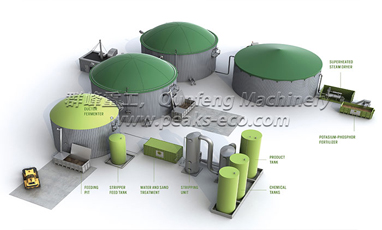In an anaerobic environment, biogas is produced when organic matter (plant and animal products) is broken down by bacteria, a process known as anaerobic digestion. Biogas systems use anaerobic digestion to recover these organic materials and convert them into biogas, which contains both energy (gas) and valuable soil products (liquid and solid).
Anaerobic digestion has occurred in nature, in landfills, and in some livestock waste management systems, but can be optimized, controlled, and controlled using anaerobic digesters. Biogas contains about 50-70% methane, 30-40% carbon dioxide, and trace amounts of other gases. Liquid and solid digestible are called digestible and are often used as soil modifiers. Some organic waste is more difficult to break down in the digester than others. Food waste, fats, oils, and fats are the easiest organic waste to break down, while livestock waste is the most difficult.
A biogas plant is a decentralized energy system, which could lead to self-sufficient heat and electricity needs while reducing the environmental pollution. Key components of modern biogas power plants (or anaerobic digestion) include feces collection, anaerobic digester, wastewater treatment, biogas storage, and biogas use/generation equipment.
Fresh animal waste is stored in a collection tank before being treated and then processed into a homogenization tank equipped with a mixer to facilitate the homogenization of the waste stream. The evenly mixed waste is passed through a macerator to obtain a uniform particle size of 5-10 mm and then pumped into an anaerobic digester of suitable capacity where the organic waste is stabilized.
In anaerobic digestion, organic matter is converted to methane and carbon dioxide by a series of bacterial communities. Most commercially operated digesters are piston-flow and fully mixed reactors operating at medium temperatures. The type of digester used varies with the consistency and solids content of the raw material, capital investment factors, and major digestive purposes.
Methane contains a large amount of hydrogen sulfide (H 2s) gas, which requires stripping due to its highly corrosive nature. The removal of H 2s was carried out in a biological desulfurization unit, where limited air was added to the methane in the presence of special aerobic bacteria that oxidize H 2s to elemental sulfur.
The methane gas is then dried and fed into a CHP unit, which leads to a generator to generate electricity and heat. The size of a CHP system depends on the amount of methane produced each day.
The digested substrate is dehydrated by a screw press, followed by daylight drying and conditioning to produce a high-quality organic fertilizer. The pressed water is treated in a wastewater treatment plant based on an activated sludge process consisting of an aeration tank and a secondary clarifier. The treated wastewater is recycled to meet the requirements within the plant.

Chemical laboratories are essential for continuous monitoring of the continuity and effectiveness of important environmental parameters (e.g., BOD, COD, VFA, pH, ammonia, C: N ratio) at different locations.
Continuous monitoring of the biogas energy plant is achieved by using remote control systems such as supervisory control and Data Acquisition (SCADA) systems. The remote system facilitates immediate feedback and adjustments, resulting in energy savings.